Home Canning Tomatoes: Tips and Simple Instructions
Just into summer and
canning tomatoes is a good idea, especially if you are like me and grow
your own. Living in the country has so many advantages, one of them
being that I can grow as many tomato varieties as I like, because I
have the space to do so.
But more importantly canned tomatoes in the summer means that when it is cold and miserable outside, and the snow is 3 feet deep, and the tomato plants have long died, I have my summer tomatoes all snug in their bottles just begging to be used in my soups and stews.
And finally, home canned tomatoes are healthy for you. They are not sitting in tin cans that may cause a reaction between the metal and the acidity in the tomatoes. And it has been researched that more lycopene is present in canned tomatoes. Lycopene helps fight cancer, so therefore canned tomatoes are well worth having in your pantries.
But more importantly canned tomatoes in the summer means that when it is cold and miserable outside, and the snow is 3 feet deep, and the tomato plants have long died, I have my summer tomatoes all snug in their bottles just begging to be used in my soups and stews.
And finally, home canned tomatoes are healthy for you. They are not sitting in tin cans that may cause a reaction between the metal and the acidity in the tomatoes. And it has been researched that more lycopene is present in canned tomatoes. Lycopene helps fight cancer, so therefore canned tomatoes are well worth having in your pantries.
Successful Steps to Home Canning Tomatoes
Tomato canning in
general is easy, as long as you maintain a high level of hygiene in
your
equipment and when processing the harvest. Tomatoes are no different
but because of their high acid content, they are one vegetable/fruit
that can be
safelyprocessed.
Choosing Tomatoes for Home Canning
When choosing which
tomatoes to use for your canning, make sure that your
tomatoes are red, ripe, but firm. You don't want to use tomatoes that
have cracks in them, or that are overripe. This is because as
tomatoes mature they lose their acidity and it is the high acidity
content in tomatoes that make them so successful as a canning
vegetable. Discard any tomatoes that are blemished or have decaying
spots as these will cause your produce to spoil.
Canning Tomatoes and Choosing the Right Variety
This
growing season I have in my vegetable garden heirloom tomatoes;
Black
Russians, San Marzano that are plum tomatoes, and an old Italian
heritage beefsteak tomato from Florence. As I have over 30 tomato
plants growing at the moment canning them will be something at the top
of my list within the next couple of weeks as they ripen.
These heirloom tomatoes are perfect for home canning but not every tomato is. A lot of hybrid tomatoes are tasteless to eat, and tasteless once canned. Make sure that you choose great heirloom varieties full of flavor. The Amish paste tomato, the Homestead 24, and Rutgers are also good canning tomato varieties.
These heirloom tomatoes are perfect for home canning but not every tomato is. A lot of hybrid tomatoes are tasteless to eat, and tasteless once canned. Make sure that you choose great heirloom varieties full of flavor. The Amish paste tomato, the Homestead 24, and Rutgers are also good canning tomato varieties.
Some
heirloom San Marzano plum tomatoes
Canning Tomatoes and Easy Peeling
The easiest way of
peeling tomatoes is to place a large saucepan half filled with water
and placed on the boil. Then place your tomatoes into a wire chip
basket
and let them stay in the boiling water for about 3 minutes. Left out
and plunge into a bowl of iced water.
Drain them off and starting with a sharp knife at the stem end, the whole tomato skins should simply slip off. If they don't you haven't left them in the water long enough.
You can remove the green core if you like, I never bother, and can them either
whole, halved or quartered.
Drain them off and starting with a sharp knife at the stem end, the whole tomato skins should simply slip off. If they don't you haven't left them in the water long enough.
You can remove the green core if you like, I never bother, and can them either
whole, halved or quartered.
Canning Tomatoes using the Hot Pack Method of Processing
This is a safe way of
processing tomatoes without the fear of botulism.
Take your peeled tomatoes and place them back on the heat. You want to heat them up but not to burn them. Once they are hot you can now place them into your jars. Pack you tomatoes into clean, sterilized glass jars and pack them to a 1/2 inch of the top of the bottle. Add 1/2 teaspoon of salt to pint jars (500 ml jars), and 1 teaspoon of salt to quarts (1 liter jars).
If your tomatoes are very ripe, no additional water or juice is needed. Also, if you pack them in tightly, you won't need any more water. However, if you feel you do, rather use the juice from the strained tomatoes when you boiled them to remove the skins. This is better than just using plain, boiled water.
Also, if your tomatoes are very ripe you may want to add some lemon juice or citric acid to your jars if you think that the acidity level of your tomatoes is not high enough. I never do this, but some of you may want to.
Add 1 tablespoon lemon juice, or 1/4 teaspoon powdered citric acid to pint jars (500 ml jars). Add 2 tablespoons of commercial bottled lemon juice, or 1/2 teaspoon powdered citric acid to quart jars (1 liter jars) of very ripe tomatoes. You may want to off-set the acid taste of this with a little bit of sugar. The amount you add will be according to taste.
Now place the lids on and turn, but do not tighten too much at this stage. Process in a boiling water bath by placing the bottles on an upturned plate or a round wire cake rack inside a large saucepan, if you don't have a canning set. Fill the pot with boiling water so that the water comes 1 inch (2.25 cm) past the jars. Boil your pint jars for 35 minutes and your quart jars for 45 minutes.
For those of you living in higher altitudes. Add the following to your processing time:
1001-3000 feet add 5 minutes
3001-6000 feet add 10 minutes
Above 6000 feet add 15 minutes
Carefully remove the jars, after the processing time, and place the jars on a dry dish towel to prevent cracking. Tighten the lids once they have cooled a bit.
If you are wanting to use your canned tomatoes for soups and stews and you don't have enough bottles, then you can just remove the skins by scalding them, as above, boil the tomatoes until tender, put them through a sieve or food mill, and boil this tomato mixture again until slightly thick. Now can in the usual way.
Take your peeled tomatoes and place them back on the heat. You want to heat them up but not to burn them. Once they are hot you can now place them into your jars. Pack you tomatoes into clean, sterilized glass jars and pack them to a 1/2 inch of the top of the bottle. Add 1/2 teaspoon of salt to pint jars (500 ml jars), and 1 teaspoon of salt to quarts (1 liter jars).
If your tomatoes are very ripe, no additional water or juice is needed. Also, if you pack them in tightly, you won't need any more water. However, if you feel you do, rather use the juice from the strained tomatoes when you boiled them to remove the skins. This is better than just using plain, boiled water.
Also, if your tomatoes are very ripe you may want to add some lemon juice or citric acid to your jars if you think that the acidity level of your tomatoes is not high enough. I never do this, but some of you may want to.
Add 1 tablespoon lemon juice, or 1/4 teaspoon powdered citric acid to pint jars (500 ml jars). Add 2 tablespoons of commercial bottled lemon juice, or 1/2 teaspoon powdered citric acid to quart jars (1 liter jars) of very ripe tomatoes. You may want to off-set the acid taste of this with a little bit of sugar. The amount you add will be according to taste.
Now place the lids on and turn, but do not tighten too much at this stage. Process in a boiling water bath by placing the bottles on an upturned plate or a round wire cake rack inside a large saucepan, if you don't have a canning set. Fill the pot with boiling water so that the water comes 1 inch (2.25 cm) past the jars. Boil your pint jars for 35 minutes and your quart jars for 45 minutes.
For those of you living in higher altitudes. Add the following to your processing time:
1001-3000 feet add 5 minutes
3001-6000 feet add 10 minutes
Above 6000 feet add 15 minutes
Carefully remove the jars, after the processing time, and place the jars on a dry dish towel to prevent cracking. Tighten the lids once they have cooled a bit.
If you are wanting to use your canned tomatoes for soups and stews and you don't have enough bottles, then you can just remove the skins by scalding them, as above, boil the tomatoes until tender, put them through a sieve or food mill, and boil this tomato mixture again until slightly thick. Now can in the usual way.
Canning Tomatoes using a Pressure Cooker or Canner
Canning tomatoes in a
pressure cooker or canner is also possible. The following cooking
times should be followed:
- Whole, hot packed tomatoes in quart jars should be processed for 10 minutes at 11 lb for 0-2000 ft. 2001-4000 feet process for 10 minutes at 12 lb. 4001-6000 ft process for 10 minutes at 13 lb, above 6000 ft process for 10 minutes using 14 lb
- Whole, hot packed tomatoes in pint jars should be processed for 15 minutes at 6 lb for 0-2000 ft. 2001-4000 ft process for 15minutes at 7 lb. 4001-6000 ft process for 15 minutes at 8 lb, above 6000 ft process for 15 minutes using 9 lb.
Finally, some Canning Tomato Tips:
- Use wide-mouth pint or quart jars for ease in filling. Although not necessary, they’ll make the entire process go faster, and you’ll have less mess.
- If you have sweetcorn in your garden and are concerned about the safety of canning it, you can actually can your corn together with your tomatoes. As corn has almost no acidity, and tomatoes have high acidity canning them together makes perfect sense.
Did you find this page helpful?
Sharing is a way of saying, "Thanks!"
Follow Us and Keep Up to Date
Don't miss out on our latest news and articles. Sign up for our free monthly e-zine!
Go from Canning Tomatoes back to Home CanningGo back to the Home Page
OTHER SECTIONS OF INTEREST
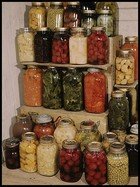 Home
Canning
Home
Canning
Canning Applesauce

Canning Baby Food
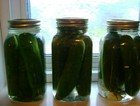
How to Make Pickles
 More
Canning Recipes
More
Canning Recipes
Home Canning Book
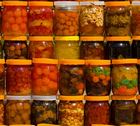
Preserving Food
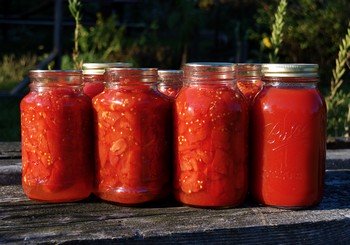
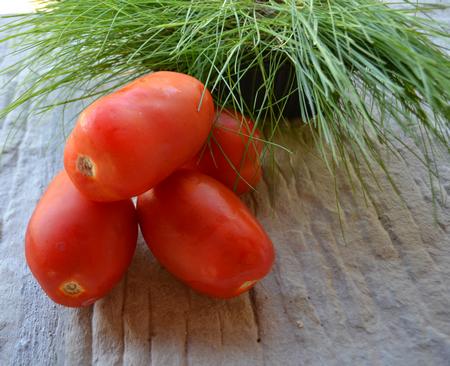



New! Comments
Do you have something of value to add? Leave me a comment in the box below.